I really hate to keep repeating myself in my year-end summations, but I just have to say it: 1988 was an abysmal year for movies. That includes the year’s big blockbuster releases (RAIN MAN, COMING TO AMERICA, TWINS, CROCODILE DUNDEE II, COCKTAIL…not exactly what I’d call Classics for the Ages) and also the lesser-known fare of the type profiled below.
To be quite honest, I’m not entirely sure that all of the following films deserve to be on this list. POWAQQATSI, THE MODERNS, PATTY HEARST and TRACK 29 all admittedly entered my life at an impressionable age, and their spell has never quite worn off. I wonder how I might have reacted to those films had I been introduced to them a few years before or later, but that surmise, obviously, is irrelevant.
On with the countdown…
30. THE CARRIER
A cheap but arrestingly weird late-80’s horror flick about a dimly glimpsed forest-dwelling creature who attacks a small town. But the critter, as it turns out, is just a catalyst, with the guy it attacked contracting an epidemic that makes people smoke and dissolve on contact with afflicted objects. Hysteria grips the town, and soon its citizenry are wrapping themselves in plastic and killing each other. The pic is, frankly, pretty silly, although it’s highlighted by some audaciously surreal imagery (mirror shards burning a woman’s flesh, cats stuck to church walls) and potent social commentary (can you really say something like this wouldn’t occur if such a disease manifested itself in your town?).
29. LANDSCAPE IN THE MIST (TOPIO STIN OMIHLI)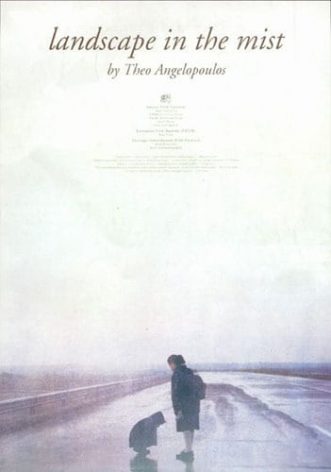
An aggravating yet affecting film from Greece’s Theo Angelopoulos about two runaway kids and the awfulness that befalls them. The kids are trying to get to Germany in order to meet up with an imaginary father, but things naturally don’t work out as they hoped. This being an Angelopoulos film, you can expect a severely drawn-out Tarkovsky-esque treatment marked by a succession of minutely detailed single-take sequences. The director’s cinematic mastery is undeniable, and he stages a couple bravura sequences: a rape within the back of a truck that we never actually see (the camera stays outside the truck observing the action around its periphery) and a bravura wide shot of a stone hand being lifted out of the sea by a helicopter.
28. DEADBEAT AT DAWN
I’ve always gotten a kick out of this revenge fest, even though it’s a tawdry and amateurish effort that looks like it had a budget of about ten cents. What it has in its favor is a surplus of energy and inspiration, courtesy of writer/director/star Jim Vanbebber, who creates a thrilling rollercoaster ride through a grungy underworld of drug addicts and gangsters. Vanbebber plays Goose, a young punk whose beloved girlfriend is killed after he decides to quit gangbanging. This inspires a bloody revenge spree, but not until after Goose has ground up his beloved’s carcass in a trash compactor and beat the shit out of his junkie father. This is, obviously, an extremely violent film, although the budget-lite gore effects ensure that none of it is ever very troubling. Rather, it’s actually a great deal of fun from start to bloody finish, even if you do have to forgive a Hell of a lot.
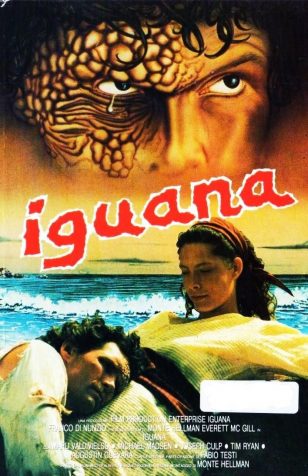 27. IGUANA
27. IGUANA
An astonishingly bleak Monte Hellman directed historical drama, starring Everett McGill as a deformed pirate who sets up a corrupt mini-empire on a deserted island. I found the film, with its unflinching violence, brooding atmosphere and authentic seafront locations, quite effective, although it’s hampered by a painfully low budget.
26. SURVIVING EDGED WEAPONS
The eighties instructional video is a format that should be familiar to all of us who came of age in that better-forgotten decade. This particular instruction video contains all the outrageous tackiness that typified such fare, reminding me of all the ludicrous how-to and do-not screeds I was force-fed in school. Granted, those videos were usually about the evils of peer pressure or drug abuse, whereas this one was made to educate cops about the dangers of knives and other sharp objects via a relentless assortment of bloody dramatizations, starting with a prehistoric caveman attacking one of his fellows. A more contemporary dramatization shows a maniac slashing off his finger tips and throwing ‘em at police officers amid a plethora of assorted slashing and stabbing. It’s all just as goofy as it sounds, but beware: amid such an exhaustive assortment of bloody mayhem it’s inevitable that some scenes hit their mark. Examples include the sight of a guy writhing on the ground after being fatally wounded and a lingering shot of a cop slowly bleeding to death in his squad car, both of which attain Genuinely Disturbing status.
25. MURDER ONE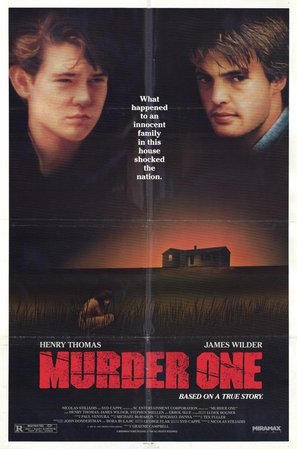
An authentically chilling drama based on a 1970s era killing spree perpetrated by two escaped con brothers, who over a twenty four hour period terrorized several states and massacred an entire family. Henry Thomas stars as the shy sibling of the killers, who goes along for the ride and then stands back horrified as his bros. commit murder after murder. Director Graeme Campbell does a good job conveying the aimlessness of the spree, although that doesn’t quite excuse the fact that the film, with its studied uneventfulness, is often downright boring.
24. TWELVE MONTHS OF SUMMER (SOMMARENS TOLV MANADER)
This TV movie curio hails from Sweden, and is quite compelling for the most part. It’s set in a land where summer lasts all year, and where a bunch of ordinary construction workers are building a structure whose exact perimeters are never determined. Along the way the workers are subjected to disquieting dreams and hallucinations, which grow so grievous that an escape plan is eventually hatched. If that synopsis sounds a bit scant for the film’s highly expansive 130 minute framework be assured that indeed it is, and the annoyingly cryptic conclusion certainly does the material no favors. But the film is never less than thoroughly intriguing, with a deceptively placid aura that rivets one’s attention throughout.
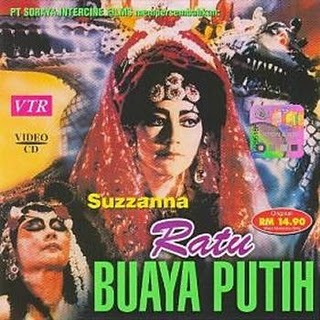 23. THE WHITE ALLIGATOR (RATU BUAYA PUTIH)
23. THE WHITE ALLIGATOR (RATU BUAYA PUTIH)
Indonesian madness with a magic alligator, a mystic queen, two mutant births, a blatant steal from THE EXORCIST, a homicidal tree and much, much overall insanity. The director was the incomparable H. Tjut Djalil, whose other credits include craptaculars like MYSTICS IN BALI, LADY TERMINATOR and DANGEROUS SEDUCTRESS, and the headliner was the late Suzzanna, Indonesian cinema’s foremost scream queen. The special effects, from the patently rubbery alligator one of the bad guys fights to the crudely animated laser beams lobbed by the gator queen to the climactic fighting tree (actually an ordinary tree rendered animate by moving the camera toward and away from it), are endearingly horrendous, and play a big hand in making THE WHITE ALLIGATOR the bad movie blast it assuredly is.
22. BLOOD DELIRIUM (DELIRIO DI SANGUE)
COMPLETELY insane Italian horror with John Phillip Law as a painter depressed over his wife’s death, a depression he gets over after hitting on the idea of using murdered women’s blood in his art. His nutcase butler assists him in this endeavor, at least until the cops close in, precipitating a jaw-dropping happy ending involving ghostly visitations that look like UFO castoffs from CLOSE ENCOUNTERS OF THE THIRD KIND. Poorly lit, choppily edited, erratically paced and largely incoherent, this is must viewing for so-bad-it’s-good movie buffs.
21. MAGIC OF THE UNIVERSE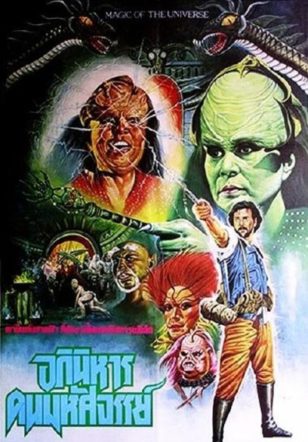
As the title suggests, this film was intended as a Filipino version of MASTERS OF THE UNIVERSE. The results, however, are vastly unlike that film, or just about anything else you’ve ever seen. In a Filipino village a magician makes his daughter disappear in what was intended as a trick. Unfortunately the girl vanishes for real, and so the magician, together with his family, visits a local sorcerer who locates the girl’s soul by imbibing a monkey’s brain straight from its skull. Yes, it’s that kind of movie! There follows a bizarre odyssey of freaky critters, a laser-beam shooting vampire, a fight to the death and an exploding forehead. The late Tara Esteban probably couldn’t make a “good” movie if his life depended on it, but he does know how to craft vivid scenes of kaleidoscopic horror. The film even contains a nifty music score that alternates spooky synthesizer cues with spirited guitar chords.
20. SALOME’S LAST DANCE
An enormously enjoyable lark from the late Ken Russell that dramatizes Oscar Wilde’s SALOME in a play-within-a-film about a private performance put on for Wilde himself—meaning practically the entire film takes place in a single room. It’s colorful and boldly staged (if a bit staid overall), and Imogen Millais Scott is quite impressive as the depraved seductress Salome, who drives her father mad after performing her infamous dance of the seven veils. Russell’s staging of the dance, set to the antic strains of “In the Hall of the Mountain King,” constitutes the film’s outrageous highlight, intercutting Scott’s gyrations with those of a male dancer (complete with a flash of the guy’s penis).
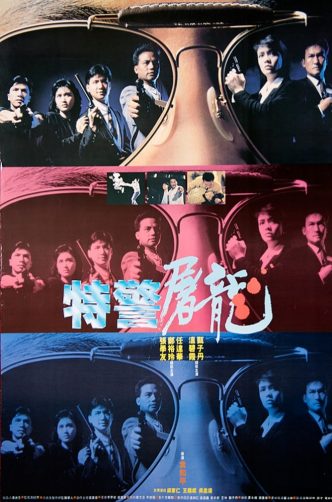 19. TIGER CAGE (DAK GING TO LUNG)
19. TIGER CAGE (DAK GING TO LUNG)
One of the most brutal of the cop movie kill-a-thons that overtook Hong Kong cinema in the late 1980s (another example of which can be found three counts down on this list), TIGER CAGE is a splat-happy adrenaline-fest about police corruption and the mob starring the HK action movie mainstays Simon Yam and Donnie Yen. There’s really no point going into the story, which as usual with this sort of fare exists essentially as a clothesline on which to hang the action sequences. As directed by the great Yuen Wo Ping (the action choreographer of the MATRIX and KILL BILL movies) those sequences are strong, gritty, fast and brutal, combining martial arts skill with copious gunplay and spilled blood.
18. A SHORT FILM ABOUT KILLING (KROTKI FILM O ZABIJANIU)
This was the first of two “Short Films” made by Poland’s late Krysztof Kieslowski (the second being A SHORT FILM ABOUT LOVE) that were in fact padded versions of episodes of Kieslowski’s ten-part DECALOGUE. A SHORT FILM ABOUT KILLING began life as episode five of THE DECALOGUE, and I’ve always felt it worked better in that format. Padded to 81 minutes (from an initial length of about an hour) it feels a bit overwrought, and the much-remarked upon cinematography by Slawomir Idziak seems a bit overdone with all its muddy filters and darkened edges. But Kieslowski’s depiction of the senseless and protracted murder of an amoral cab driver, followed by the equally protracted—and, it seems, equally senseless—execution of the teenaged killer, is undeniably powerful. The film is perhaps most interesting as an object lesson in the links between art and exploitation; certainly its presentation of the cab driver’s murder would be dismissed as exploitive had Jess Franco staged it, as would the near-fetishistic attention paid the preparation and carrying out of the climactic execution, yet the film was widely hailed for its ugliness and proclaimed a masterpiece. It’s the very definition of artsploitation!
17. PIN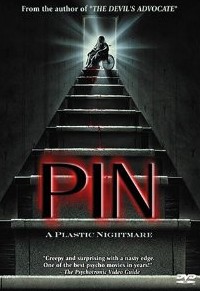
A stronger-than-average psycho thriller from Canada, based on the 1981 novel by Andrew Neiderman. It involves a teenaged brother and sister left orphaned by the deaths of their parents, with only their doctor father’s see-through medical dummy Pin for company; creepiness, as you might guess, ensues. I don’t agree with all the choices made by PIN’S writer-director Sandor Stern, but he directs with a sure and unobtrusive hand, and his script delineates its protagonists’ growing insanity in clear and unobtrusive fashion. The inanimate Pin is a marvelous creation with hypnotic blue eyes; Pin could very easily have ended up looking silly, but comes off as creepy and appropriately menacing, just as the filmmakers intended. The film, unfortunately, fails to rise above its ultra-low budget: note the chintzy lighting, amateurish performances, tacky score and cop-out ending that forsakes the unflinching darkness of the novel in favor of a wholly inappropriate, falsely optimistic fade-out (which among other sins posits that a character who was supposed to be dead somehow survives).
16. THE BIG HEAT (SENG FAT DAK GING)
THE BIG HEAT, director Fritz Lang’s enormously successful fifties-era film noir, was remade in Hong Kong over thirty years later. This new BIG HEAT arrived in HK’s post BETTER TOMORROW period, when violence-heavy cop movies were all the rage. Much of the narrative of the Lang film was thrown out in favor of a typically over-the-top spectacle of male bonding and bloodletting that begins with a close-up of a hand getting drilled and continues in that vein throughout. The films lacks the polish of the John Woo films it was patterned after, but nearly makes up for it with some brilliant blood-spattered set pieces. Among the latter is an astounding freeway-set shootout in which a man gets knocked off a bridge and flipped over the top of a speeding car, and also the balls-to-the-wall climax, an undoubted highlight of down-and-dirty action filmmaking.
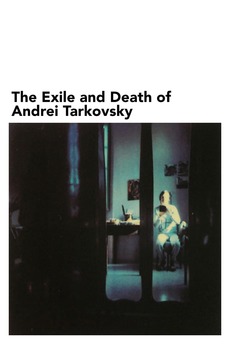 15. THE EXILE AND DEATH OF ANDREI TARKOVSKY (AUF DER SUCHE NACH DER VERLORENEN ZEIT. ANDREJ TARKOWSKIJS EXIL UND TOD)
15. THE EXILE AND DEATH OF ANDREI TARKOVSKY (AUF DER SUCHE NACH DER VERLORENEN ZEIT. ANDREJ TARKOWSKIJS EXIL UND TOD)
The final years of Andrei Tarkovsky are examined in this German documentary. It’s done up in highly impressionistic, near-Tarkovskian fashion, with lengthy stretches of silence punctuating the expected interviews and voice-over narration. The latter consists largely of excerpts from Tarkovsky’s diaries, which detail how miserable his life was after he was exiled from his native Russia and forced to live as a penniless nomad in Europe. All the time he suffered from agonizing homesickness—or, as the Russians term it, Nostalghia—expressed in his 1984 film of that title and his final work THE SACRIFICE. Eventually Tarkovsky was diagnosed with cancer and hospitalized, with his witchy wife leaving him to die alone in early 1986. We also see footage of Tarkovsky being snubbed at Cannes, a woman journalist complaining about his apparently misogynistic nature, and a rare interview with Tarkovsky’s teenaged son, who seems remarkably cool in discussing his relationship with his deceased father. Obviously this isn’t a cheery account, and nor is it a particularly exciting one, but it is very much in keeping with the tortured spirit of its subject.
14. CITY ZERO (GOROD ZERO)
This Russian surreal fest plays a bit like an Eastern-styled AFTER HOURS, albeit with the weirdness quotient multiplied exponentially. A suit-wearing guy steps off a train in a mysterious town where he’s looking to do business. That he’s stepped into a madhouse becomes evident quite quickly, when he enters the office of his client to find a fully nude secretary. In a restaurant he’s served a cake styled as an exact replica of his face and head, which the waiter gleefully carves up; when the guy protests that he didn’t order dessert another waiter shoots himself. More weirdness follows, including a peek into an elaborate wax museum depicting the entire history of Russia and a kid who approaches the protagonist and predicts the day and manner of his death. Worst of all is that no matter how hard he tries the poor guy can’t seem to leave the town, and becomes directly entangled in its machinations when the local police open an investigation into the waiter’s suicide. Director Karen Shakhnazarov (best known these days for 2004’s THE RIDER NAMED DEATH) lends the proceedings a spare, deliberate style that in its quiet way manages to compel even when the “action” flags. Shakhnazarov’s aims were apparently political in nature, but, not being Russian, that aspect naturally went over my head; the film, however, works just fine as a straightforward exercise in Kafka-esque absurdity.
13. TIMES TO COME (LO QUE VENDRA)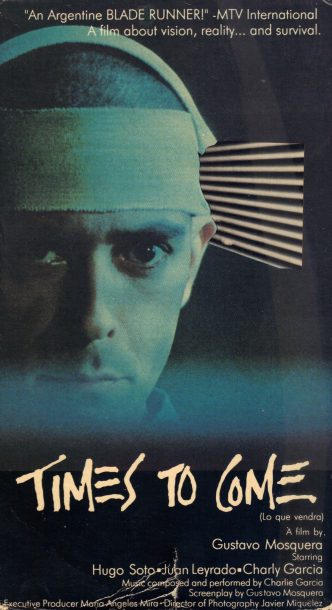
Goddamn if this Argentine sci fier isn’t one of the most stylish films I’ve ever seen. Of course, it’s also extremely arty, demanding and often downright dull. The story (what there is of one) pivots on a man (Hugo Soto from MAN FACING SOUTHEAST) living in in a nightmarish futuristic metropolis who’s injured in a political demonstration. Recuperating in a hospital (whose staffers are nearly all on strike), he comes into contact with a number of odd characters, including the corrupt cop who did the shooting, a vigilante looking to screw over said cop and a woman with a deep-seated “interest” in our protagonist. It all ends in a chase through a vast structure where a mysterious old guy appears to inform the protagonist that he’s just a pawn of godlike rulers, and that he should go home and relax, as things will only get worse in “times to come.” The direction by Gustavo Mosquera (MOEBIUS) is stunning, utilizing distorted lenses and bizarre camera angles to hypnotic effect, and the minimalist score by Argentine rock star Charly Garcia (who also plays the vigilante) provides an appropriately brooding accompaniment.
12. BRAIN DAMAGE
This, the second film by Frank Henenlotter, is even sicker than BASKET CASE, his first. It may be a bit too slow overall (with much obvious padding), but BRAIN DAMAGE is such a cheap, vile and outrageous good time it nearly attains rotgut classic status. The story concerns a dude who falls under the influence of a slug-like monster named Aelmer who eats brain matter; in exchange for unwilling victims whose brains he can suck, Aelmer injects a hallucinogenic fluid into his human host’s head. This allows for some pleasing hallucinatory sequences (a lighting fixture turning into an eyeball, etc.), not to mention one of the most hysterically offensive scenes of all time (you’ll know which one!).
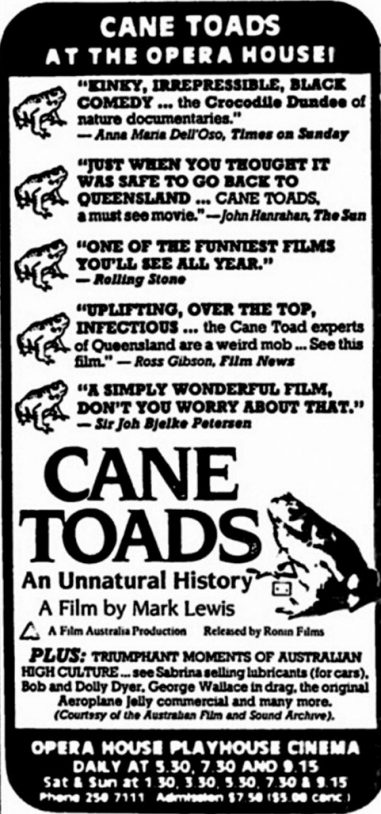 11. CANE TOADS: AN UNNATURAL HISTORY
11. CANE TOADS: AN UNNATURAL HISTORY
This deeply eccentric Aussie documentary is a non-stop laugh riot depicting the rise of the Cane Toad. These omnivorous, sex-crazed critters were imported into Australia from Hawaii in the 1950’s to combat a species of insect that was destroying cane plants. Unfortunately the toads multiplied to the point that now (or at least when this movie was made) they’ve pretty much taken over the nation, eating everything that moves and mating nonstop. This terrifically inventive 50-minute film is played mostly for laughs, complete with side splitting “recreations” (such as a staged recollection of a toad ravishing its squashed partner at the side of a road) and toad POV shots.
10. GANDAHAR (LIGHT YEARS)
A typically whacked-out animated science fiction epic from FANTASTIC PLANET creator Rene Laloux. GANDAHAR exists in an Americanized version recut by Harvey Weinstein (Mr. “Edward Scissorhands” himself), but I think it goes without saying that the French language original is far preferable. It’s set on a distant planet where a variety of strange creatures reside alongside a race of genetically altered humans. There’s trouble in the form of people being inexplicably turned to stone; a heroic muscle-head is charged with finding out what’s going on, and discovers a giant brain called Metamorphis, an unfortunate result of scientific experimentation by the very people Metamorphis is now seeking to destroy. Actually, he’s turning them to stone then sealing ‘em up in large eggs, which are then sent through a time portal that deposits them a thousand years in the future, where they’re somehow transformed into emotionless robots that come back through the portal to do Metamorphis’s dastardly bidding. GANDAHAR is quite similar to FANTASTIC PLANET in its oddly serene atmosphere, highly allegorical narrative and organic scenery, which resembles nothing so much as human organs. It lacks the warped genius of Roland Topor, who co-wrote and designed the earlier film, but still manages to startle, particularly the unforgettable climax, in which Metamorphis is destroyed in a hallucinogenic swirl of light and color.
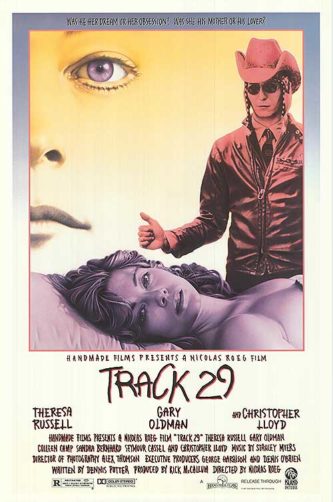 9. TRACK 29
9. TRACK 29
My first viewing of TRACK 29 back in ‘88 remains permanently scarred upon my psyche. It’s one of the most outrageously brain-fried films of the eighties, and no surprise, as it was written by the late Dennis Potter (THE SINGING DETECTIVE) and directed by the inimitable Nicolas Roeg (no elaboration necessary). Electric trains as a sexual surrogate, a British nutcase literally appearing out of thin air screaming “MOTHER!,” a fairground rape, a psychotic housewife, a perverted nurse and a blood-stained ceiling are just a few of delirious oddments on display here. General audiences and critics will (and do) loathe this film, but I say it’s a bizarre movie buff’s wet dream.
8. ON THE SILVER GLOBE (NA SREBRNYM GLOBIE)
This frenzied sci fi epic hails, unsurprisingly, from Poland’s wildest filmmaker Andrzej Zulawski. Lensed back in 1978, it might conceivably have attained masterpiece status but for the fact that its backers pulled the plug before filming was complete, allegedly due to budget overruns. It wasn’t until 10 years later that Zulawski pieced together the footage of ON A SILVER GLOBE and overlaid it with hasty voice-over narration (to fill in the portions that were never shot). The result is a fascinating but ultimately frustrating spectacle that, again, could have been great. The story, taken from a three-volume tome written in the early 1900’s, concerns some astronauts who flee the earth. Landing upon a distant planet, they waste no time having sex and popping out multiple offspring who in turn grow up to be pagan barbarians. When an Earthman visits several years later he’s crowned a God, and leads an uprising against a race of mutant birdmen who have enslaved the planet; eventually, however, this false messiah’s subjects grow disenchanted and crucify him. That’s a (very) brief summation of an incredibly wide-ranging, multi-character piece that works best as an unabashed wallow in sheer excess. Visually the film is astonishing, with artfully spastic camerawork and distorted lenses unforgettably conveying a world succumbing to madness and anarchy. Yes, there’s plenty of gore and not a little sex in this 160-minute odyssey, which also contains some of the most outlandish sights I’ve seen in any movie, in particular a cave meeting that devolves into a giant orgy and an astounding wide shot depicting dozens of unfortunate folks impaled atop hundred foot spikes.
7. GHOSTS…OF THE CIVIL DEAD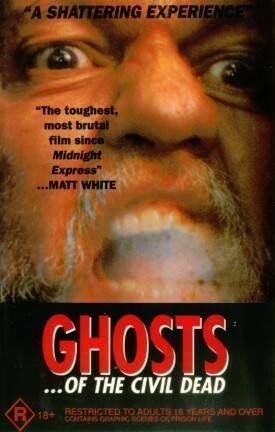
Quite possibly the greatest prison movie ever made, an utterly relentless depiction of a “New Generation” underground detention center in Australia. In direct contrast to most prison films this one has a deceptively quiet, stately veneer—albeit one that’s periodically interrupted by bursts of shocking violence. The cast, which includes the film’s co-scripter Nick Cave and a number of few real-life ex-cons, are all utterly convincing as spiritless “lifers,” and first-time director John Hillcoat adroitly shows how these no-hopers are intentionally stirred up by corrupt superiors (to demonstrate how terrible conditions are and so increase their already inflated budgets). My only beef: since the film a). was heavily inspired by the writings of the Yank ex-con Jack Henry Abbot (IN THE BELLY OF THE BEAST), b). was patterned after a real incident that occurred in an Illinois prison, c). had its prison modeled on American institutions, and d). was largely filmed here in the US, why is it set in Australia when the subject matter is so patently all-American?
6. PATTY HEARST
In which the story of the 1974 abduction and brainwashing of Patricia Campbell Hearst was reconfigured as a CABINET OF DR. CALIGARI-esque horror show. PATTY HEARST was largely shunned by critics and audiences, although Natasha Richardson, in her first noteworthy movie role, was rightly singled out for praise. The film is not the standard-issue based-on-fact crime drama it was falsely advertised as, but an expressionistic horror-art film courtesy of the great Paul Schrader. The early scenes of Patty’s abduction, with their distorted set design, skewed camera angles and stark, shadowy photography, illustrate this point admirably. From there the proceedings morph into a more naturalistic but still quite eccentric drama packed with flamboyant touches like a security camera’s eye view of a bank heist (replicating footage that was actually broadcast on TV back in the seventies) and surreal ceiling-less sets. The cast is packed with strong actors—Ving Rhames, Dana Delany, William Forsythe—but none more so than Ms. Richardson, who succeeds in rendering Patty compelling and sympathetic despite the fact that her role is largely reactive. This is doubtless a large part of what makes this strange, sustained nightmare of a movie so provocative—and also why it’s been so universally maligned.
5. ALICE (NECO Z ALENKY)
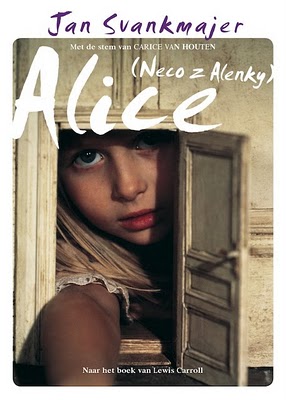 The astounding feature debut of the Czech animator Jan Svankmajer, who provides a defiantly surreal reinterpretation of ALICE IN WONDERLAND. As befitting Svankmajer’s East European sensibilities, the film is set mostly in somebody’s cluttered flat, where the young Alice finds herself cavorting amid a plethora of living dolls and puppets. She’s turned into a doll herself on more than one occasion, has a tiny dude build a campfire atop her head and gets involved in a mad tea party, where she has to keep winding up the Mad Hatter and face down the Queen, who presides over a kingdom of paper cut-outs (and beheads ‘em with scissors). Svankmajer’s blend of live action and stop motion animation is utterly distinctive, and has a definite homemade charm. His obsessive attention to minute detail is also interesting, and makes for films—his subsequent features FAUST, CONSPIRATORS OF PLEASURE and LITTLE OTIK are every bit as mind-roasting as this one—that are unique in modern cinema. I do have one problem, though: the character’s voices are all spoken by Alice, which is fine, but after every utterance Svankmajer insists on cutting to a close-up of Alice’s lips telling us who just spoke (“Said the White Rabbit,” “Uttered the Mad Hatter,” “Cried the Queen”), which becomes might mighty obnoxious after a while. The device is paid off (somewhat) in the final shot, but that doesn’t make it any less irritating.
The astounding feature debut of the Czech animator Jan Svankmajer, who provides a defiantly surreal reinterpretation of ALICE IN WONDERLAND. As befitting Svankmajer’s East European sensibilities, the film is set mostly in somebody’s cluttered flat, where the young Alice finds herself cavorting amid a plethora of living dolls and puppets. She’s turned into a doll herself on more than one occasion, has a tiny dude build a campfire atop her head and gets involved in a mad tea party, where she has to keep winding up the Mad Hatter and face down the Queen, who presides over a kingdom of paper cut-outs (and beheads ‘em with scissors). Svankmajer’s blend of live action and stop motion animation is utterly distinctive, and has a definite homemade charm. His obsessive attention to minute detail is also interesting, and makes for films—his subsequent features FAUST, CONSPIRATORS OF PLEASURE and LITTLE OTIK are every bit as mind-roasting as this one—that are unique in modern cinema. I do have one problem, though: the character’s voices are all spoken by Alice, which is fine, but after every utterance Svankmajer insists on cutting to a close-up of Alice’s lips telling us who just spoke (“Said the White Rabbit,” “Uttered the Mad Hatter,” “Cried the Queen”), which becomes might mighty obnoxious after a while. The device is paid off (somewhat) in the final shot, but that doesn’t make it any less irritating.
4. THE MODERNS
Alan Rudolph’s cockeyed take on Paris in 1926 (actually Montreal in 1987, but the illusion is sustained quite well) stars Keith Carradine as an American art forger, Linda Fiorentino as his sultry wife and John Lone as her evil Chinese BF. The film contains all of Rudolph’s trademarked quirky romance, but it’s also a dreamy rumination on art and commerce that favorably recalls the best work of Rudolph’s mentor Robert Altman. Whatever THE MODERNS is, it’s an incredibly stylish and colorful (though often agonizingly self-indulgent) piece of work. Also featuring Kevin O’Connor as Ernest Hemingway, Elsa Raven as Gertrude Stein and Ali Giron as Alice B. Tolkas.
3. PAPERHOUSE
One of the most remarkable horror films of the eighties, an intelligent and imaginative British-made triumph of old fashioned 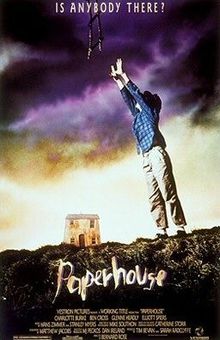 storytelling brio. It’s about a young girl who dreams of an eerie house directly inspired by a drawing she made. She finds that when she adds to the drawing those additions color her dreams, which come to include a paralyzed boy named Mark and a foreboding figure patterned on the girl’s absentee father. Charlotte Burke is quite winning as the protagonist, playing her as a sympathetic yet frequently bratty and selfish girl—in other words, a gal who could have been directly plucked from the real world. The late American actress Glenne Headly (sporting a convincing British accent) is also quite fine as the girl’s distraught mother, and writer-director Bernard Rose adroitly imparts a steadily building sense of foreboding horror. Furthermore, he concludes PAPERHOUSE with an epic flourish that renders it virtually unique among eighties-era genre films.
storytelling brio. It’s about a young girl who dreams of an eerie house directly inspired by a drawing she made. She finds that when she adds to the drawing those additions color her dreams, which come to include a paralyzed boy named Mark and a foreboding figure patterned on the girl’s absentee father. Charlotte Burke is quite winning as the protagonist, playing her as a sympathetic yet frequently bratty and selfish girl—in other words, a gal who could have been directly plucked from the real world. The late American actress Glenne Headly (sporting a convincing British accent) is also quite fine as the girl’s distraught mother, and writer-director Bernard Rose adroitly imparts a steadily building sense of foreboding horror. Furthermore, he concludes PAPERHOUSE with an epic flourish that renders it virtually unique among eighties-era genre films.
2. TALES FROM THE GIMLI HOSPITAL
Many features have attempted to match the surreal flavor of David Lynch’s all-time classic ERASERHEAD, but only this 68 minute black & white no-budgeter has truly succeeded (well, along with BEGOTTEN). It was the debut feature by everybody’s favorite Manitoban madman Guy Maddin, and remains one of the purest distillations of his unique cinematic vision. Set in the economically depressed Canadian province of Gimli in the early 1900s, it focuses on Ainar and Gunnar, both of whom suffer from a strange pestilence. Confined to the eponymous hospital (together with a staff of cute pre-pubescent nurses), these two loons reminisce about past experiences, and come to realize that they’re both perverts—even worse, Ainar reveals that he once ravished Gunnar’s dead girlfriend (yes, you read that right: Ainar had her after she was dead). They hallucinate wildly (among other things, Ainar imagines the cheesiest Busby Berkeley-styled pool dance you’ve ever seen) and finally take one another on in an epic butt-pinching match (actually a real form of Canadian wrestling). This is pure, deranged genius, done in Maddin’s inimitably tacky, mock silent-movie style.
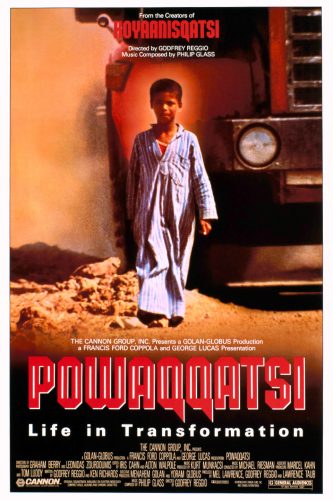 1. POWAQQATSI
1. POWAQQATSI
Director Godfrey Reggio’s follow-up to the legendary KOYAANISQATSI, which, as you may recall, utilized a dialogue free quasi-documentary format, augmented by a superb Philip Glass score. Reggio does the same thing here, and while the results never came close to attaining the success of KOYAANISQATSI, I say POWAQQATSI is the superior work. In the former film Reggio focused on the United States and its transition to a technology-based culture, whereas here he looks in on a number of disparate third world countries. We’re never told where we are, and it doesn’t really matter anyway, with the first quarter taken up with “primitive” cultures in India and Africa while the second takes us to more developed nations like Brazil and Hong Kong, where poverty and despair run rampant. Scene after incredible scene nails what heavyweights like Herzog and Tarkovsky have attempted (and often failed at), presenting an unforgettable portrait of mankind’s oft-unstable place in the universe through some of the most stunning moments I’ve seen in any film. Examples include the South American mine set opening wherein a guy dies and so becomes another piece of dead weight to be carried up the hill, the euphoric Indian dance sequence (undoubtedly one of the most perfect fusions of sound and image ever) and a rather upsetting depiction of a young girl forced to maneuver a donkey-drawn cart through a busy street with her father passed out beside her.
